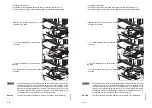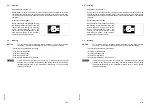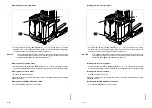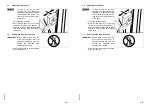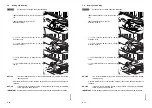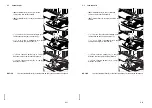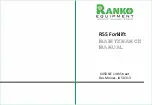
0
608
.USA
E 46
Parts of the load, machine, materials or structural equipment projecting permanently
or temporarily into the normal working area must be appropriately protected and
clearly marked.
Lighting of operating areas:
The operating areas must be adequately lit in
accordance with ANSI / IES RP7, (see also 29 CFR 1910.178 (h) with regard to the
installation of additional lamps for the direction indicator.
The owner is responsible for fitting an industrial truck or hauler with operating lights if
working conditions require it.
Noise level:
The use of powered industrial trucks can contributed to an elevated
noise level in the work environment. Consideration must, therefore, be given to the
noise pollution affecting employees in the work environment.
Loading ramps (loading aisles)
1
:
The load capacity of portable and powered
loading ramps must be clearly marked. The specified load capacity must not be
exceeded.
The position of loading ramps must be fixed either by anchors or by devices to
prevent the loading ramps from being moved.
The loading ramps must have handles or other effective devices allowing them to be
handled safely. Where possible they should be fitted with fork loops or lifting eyes with
which they can be carried by industrial trucks.
All types of loading ramps should have a non-slip surface to prevent employees or
industrial trucks from slipping.
To prevent the loading ramps from wobbling or sliding, all types of loading ramp must
be designed and maintained in such a way that one end is permanently attached to
the loading ramp and the other to the transport vehicle.
All loading ramps and transition plates must be designed and maintained so that a
smooth and horizontal transition is provided between the individual working areas.
An adequate safe distance must be maintained from the edge of the ramp, platform
or other work area.
Freight trucks (with / without trailers) and rail cars:
Q
wW
To avoid dangerous situations, the following instructions must be read
carefully before driving an industrial truck onto a freight truck (with / without
trailer) or a rail car.
If a powered industrial truck is driven onto freight trucks or trailers, they must be
immobilized with the parking brake and wheel chocks or other appropriate devices to
prevent the freight truck or trailer from being moved accidentally.
1.The recommendations for loading ramps apply also to loading aisles.
0
608
.USA
E 46
Parts of the load, machine, materials or structural equipment projecting permanently
or temporarily into the normal working area must be appropriately protected and
clearly marked.
Lighting of operating areas:
The operating areas must be adequately lit in
accordance with ANSI / IES RP7, (see also 29 CFR 1910.178 (h) with regard to the
installation of additional lamps for the direction indicator.
The owner is responsible for fitting an industrial truck or hauler with operating lights if
working conditions require it.
Noise level:
The use of powered industrial trucks can contributed to an elevated
noise level in the work environment. Consideration must, therefore, be given to the
noise pollution affecting employees in the work environment.
Loading ramps (loading aisles)
1
:
The load capacity of portable and powered
loading ramps must be clearly marked. The specified load capacity must not be
exceeded.
The position of loading ramps must be fixed either by anchors or by devices to
prevent the loading ramps from being moved.
The loading ramps must have handles or other effective devices allowing them to be
handled safely. Where possible they should be fitted with fork loops or lifting eyes with
which they can be carried by industrial trucks.
All types of loading ramps should have a non-slip surface to prevent employees or
industrial trucks from slipping.
To prevent the loading ramps from wobbling or sliding, all types of loading ramp must
be designed and maintained in such a way that one end is permanently attached to
the loading ramp and the other to the transport vehicle.
All loading ramps and transition plates must be designed and maintained so that a
smooth and horizontal transition is provided between the individual working areas.
An adequate safe distance must be maintained from the edge of the ramp, platform
or other work area.
Freight trucks (with / without trailers) and rail cars:
Q
wW
To avoid dangerous situations, the following instructions must be read
carefully before driving an industrial truck onto a freight truck (with / without
trailer) or a rail car.
If a powered industrial truck is driven onto freight trucks or trailers, they must be
immobilized with the parking brake and wheel chocks or other appropriate devices to
prevent the freight truck or trailer from being moved accidentally.
1.The recommendations for loading ramps apply also to loading aisles.
Summary of Contents for ETR 314
Page 1: ...Operating instructions 50 452 907 ETR 314 320 u 06 06 11 09 07 08 E Manual de instrucciones...
Page 7: ...0608 USA I 4 0608 USA I 4...
Page 9: ...0606 USA A 2 0606 USA A 2...
Page 24: ...D 9 0107 USA D 9 0107 USA...
Page 26: ...D 11 0107 USA D 11 0107 USA...
Page 103: ...0107 USA F 10 0107 USA F 10...
Page 123: ...0708 USA G 20 0708 USA G 20...
Page 135: ...0608 E I 4 0608 E I 4...
Page 137: ...0606 E A 2 0606 E A 2...
Page 152: ...D 9 0107 E D 9 0107 E...
Page 154: ...D 11 0107 E D 11 0107 E...
Page 225: ...0608 E E 66 0608 E E 66...
Page 235: ...0107 E F 10 0107 E F 10...
Page 255: ...0708 E G 20 0708 E G 20...

